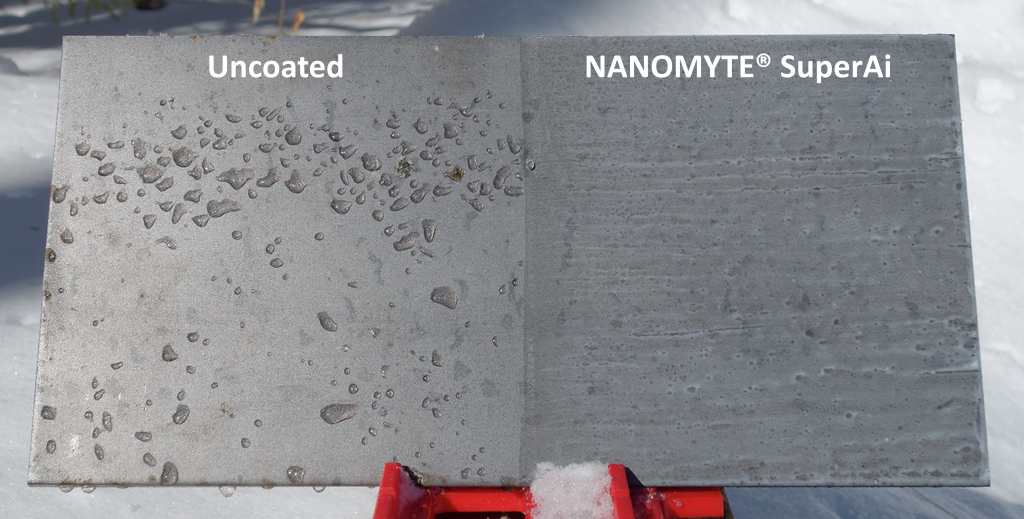New Anti-ice System Advances to Next Technology Level
Full-scale Prototype Demonstration of a New Hybrid Technology to Prevent Icing on Aircraft and Drones
January 15, 2020
Somerset, NJ (USA) – Invercon Inc. and NEI Corporation announced today that their newly developed de-icing system was tested successfully at the NASA Glenn Research Center’s Icing Research Tunnel. The test was witnessed by engineers and scientists at the Research Center, as well as from the industry. The Invercon-NEI team met the objective of demonstrating a low power anti-ice system in conjunction with NEI’s NANOMYTE® SuperAi anti-ice coating that prevents ice accretion on the leading edge of an airfoil. The test was performed on a full-size airfoil under simulated in-flight conditions, following nearly two years of development and laboratory testing.
All commercial aircraft have a built-in ice protection system, which could be either a thermal, thermo-mechanical, electro-mechanical, or pneumatic system. A common issue with de-icing devices is that they consume substantial power. Aircraft generally look to reduce power consumption, and with the advent of battery-powered aircraft, mechanisms or features that reduce power consumption are critically important. Icing presents a particular challenge for commercial and military drones, where ice can build up on the wings and propellers and result in crashes. In fact, the current practice is not to fly drones when icing conditions are predicted. Applying a passive anti-ice coating that functions synergistically with an active de-icing device is an attractive hybrid approach, which the team of NEI and Invercon has now demonstrated on full-scale prototypes.
NEI’s NANOMYTE® SuperAi anti-ice coating is a durable coating, suitable for permanent application. The coating leads to a lubricating surface that drastically reduces the adhesion strength of ice – by as much as 80%, compared to bare polished aluminum. The coating is usually applied by spraying, similar to conventional painting. NANOMYTE® SuperAi coating is available for commercial use.
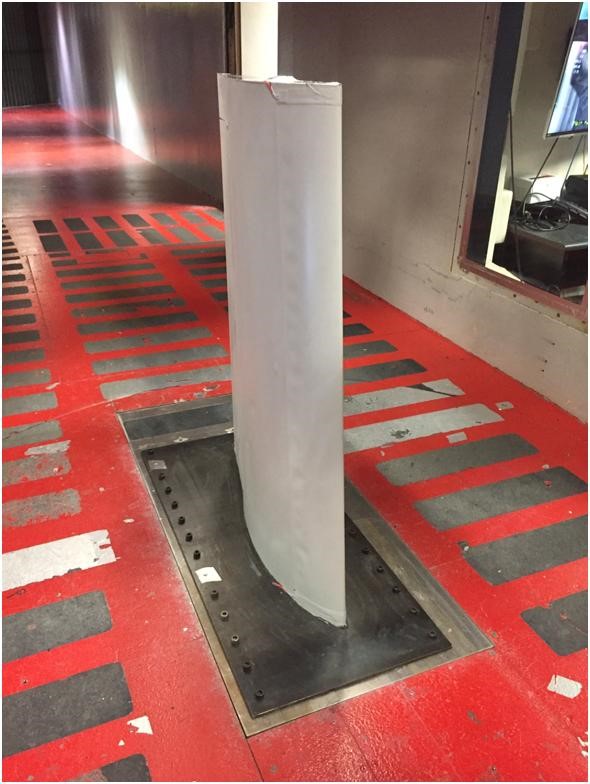
Figure 1: MQ-1 wing test section installed in the IRT tunnel.
Invercon has developed a new, retrofittable, electro-pneumatic deicing system that combines the most attractive aspects of several existing systems without their associated drawbacks. The Invercon system requires remarkably low power (≤ 2.5 kW), is retrofittable on any airfoil, adds very little weight (~50 lbs), and is durable enough to last the life of the aircraft once retrofitted. Importantly, the system looks, feels, and acts like the original leading edge and can provide millions of maintenance-free deicing cycles. The entire wing test section (Figure 1) was coated with NANOMYTE® SuperAi.
Invercon successfully completed icing tests of the electro-pneumatic deicing system at NASA Glenn’s Icing Research Tunnel (IRT) under a full range of representative icing conditions. The Invercon system was able to provide continuous deicing of the wing section leading edge over all of the test conditions ranging from temperatures of -3°C to -20°C with various liquid water content. Typically, the system allows ice to accrete for about 2 minutes and then completely sheds upper and lower surface ice upon system activation.
The testing at NASA’s IRT, which is the longest running icing facility in the world, has moved the hybrid technology to a readiness level of 6 (i.e., TRL6), which is a scale used by NASA and Department of Defense to gauge the maturity level of a technology.
Both NEI Corporation and INVERCON LLC are grateful for the financial support extended by the Small Business Innovation Research Program from the Air Force and NASA. The SBIR program funds product development efforts that reduce concepts to practice and then to prototypes, thereby reducing technology risk. The successful full-scale demonstration by the team has advanced a new technology to a state of commercial readiness.
View / Download Press Release (pdf) ⇓
About NEI Corporation:
NEI Corporation is an application-driven company that utilizes nanotechnology to develop and produce advanced materials. The company’s core competencies are in synthesizing nanoscale materials and prototyping products that incorporate the advanced materials. NEI offers an array of Advanced Protective Coatings for metal and polymer surfaces. The coatings have tailored functionalities, such as anti-corrosion, self-healing, scratch resistance, ice-phobic, and self-cleaning.
For more information, give us a call or email us.
About Invercon LLC:
Invercon’s mission is to develop advanced technologies that enable revolutionary leaps forward in aircraft performance and safety. For rotorcraft, these include centrifugally powered, pneumatic actuation systems that can actively trim rotors and de-ice rotor blades using almost no power or weight, resulting in significantly improved performance and safety. For fixed wing aircraft, Invercon has developed extremely low power deicing solutions using a novel electro-pneumatic actuation approach.
For more information, give us a call or email us.
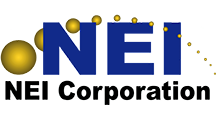
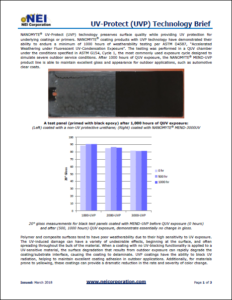
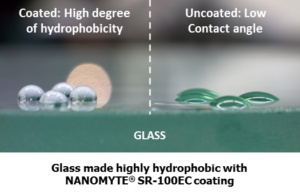 The recently allowed patent application describes durable hydrophobic coating compositions that are highly desirable for numerous applications, as they impart easy-to-clean and stain-resisting properties to surfaces. For aesthetic reasons, there is also a need for a thin, transparent, easy-to-clean coating that does not add excess weight and does not change the appearance of the substrate to be coated. The patented compositions are comprised of functionalized perfluoropolyethers (PFPEs), which are known for their non-stick and lubricating properties. It has been a major technical challenge to incorporate PFPEs into a stable formulation that can lead to a coating with sufficient adhesion to various substrates. The patent claims transparent and homogeneous compositions that overcome the stability and adhesion issues. The compositions result in a micron-thick, durable hydrophobic coating that cannot easily be removed by abrasion, harsh cleaners, or chemicals. The patent is the basis for NEI’s hydrophobic coating products,
The recently allowed patent application describes durable hydrophobic coating compositions that are highly desirable for numerous applications, as they impart easy-to-clean and stain-resisting properties to surfaces. For aesthetic reasons, there is also a need for a thin, transparent, easy-to-clean coating that does not add excess weight and does not change the appearance of the substrate to be coated. The patented compositions are comprised of functionalized perfluoropolyethers (PFPEs), which are known for their non-stick and lubricating properties. It has been a major technical challenge to incorporate PFPEs into a stable formulation that can lead to a coating with sufficient adhesion to various substrates. The patent claims transparent and homogeneous compositions that overcome the stability and adhesion issues. The compositions result in a micron-thick, durable hydrophobic coating that cannot easily be removed by abrasion, harsh cleaners, or chemicals. The patent is the basis for NEI’s hydrophobic coating products, 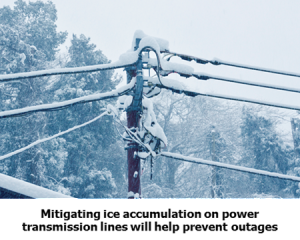 Gains in productivity and efficiency are possible when a coating or surface treatment provides functionalities beyond the usual protective and aesthetic properties. This realization has sparked great interest in functional coatings in recent years for applications that traditionally have not used paints or coatings. A good example is the use of anti-ice coatings on power transmission lines. Mitigating ice accumulation will help prevent power outages, which has a tangible and beneficial economic impact. Another example is the use of a surface treatment to increase the efficiency of power generation turbines.
Gains in productivity and efficiency are possible when a coating or surface treatment provides functionalities beyond the usual protective and aesthetic properties. This realization has sparked great interest in functional coatings in recent years for applications that traditionally have not used paints or coatings. A good example is the use of anti-ice coatings on power transmission lines. Mitigating ice accumulation will help prevent power outages, which has a tangible and beneficial economic impact. Another example is the use of a surface treatment to increase the efficiency of power generation turbines.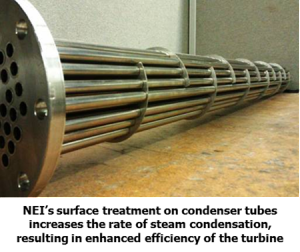
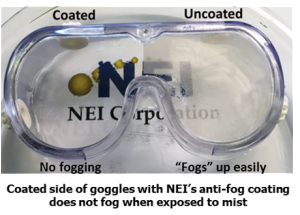 More often than not, many of the functionalities mentioned above need to be integrated into a single coating or surface treatment. For example, a transparent coating that resists finger printing also needs to be scratch resistant and durable. A coating that prevents fogging in eyewear and other transparent surfaces must also be durable and resistant to chemicals. Further, in order to meet the cost criteria, application of the coating must be compatible with conventional coating methods such as spray, dip, brush or flow. Over the past few years, NEI Corporation’s concerted efforts to develop and implement practical, multi-functional coatings are now coming to fruition.
More often than not, many of the functionalities mentioned above need to be integrated into a single coating or surface treatment. For example, a transparent coating that resists finger printing also needs to be scratch resistant and durable. A coating that prevents fogging in eyewear and other transparent surfaces must also be durable and resistant to chemicals. Further, in order to meet the cost criteria, application of the coating must be compatible with conventional coating methods such as spray, dip, brush or flow. Over the past few years, NEI Corporation’s concerted efforts to develop and implement practical, multi-functional coatings are now coming to fruition.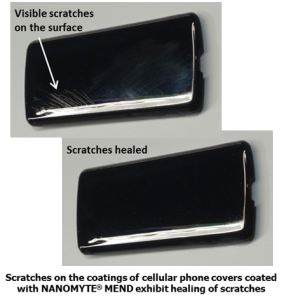 Backed by a bevy of issued and pending patents, NEI has introduced an array of coating products under the registered trade name NANOMYTE®. For example,
Backed by a bevy of issued and pending patents, NEI has introduced an array of coating products under the registered trade name NANOMYTE®. For example, 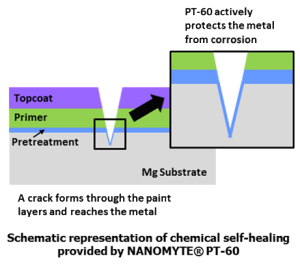 Self-healing principles can also be applied to surface treatments of metals, whereby the pretreatments can mimic the performance of chromate conversion coatings. To this end, NEI has developed a series of pretreatments for different metals where a chemical self-healing mechanism imparts corrosion resistance. For example,
Self-healing principles can also be applied to surface treatments of metals, whereby the pretreatments can mimic the performance of chromate conversion coatings. To this end, NEI has developed a series of pretreatments for different metals where a chemical self-healing mechanism imparts corrosion resistance. For example, 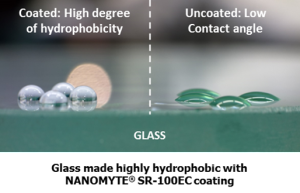 Durable hydrophobic coatings are highly desirable for numerous applications as they usually impart easy-to-clean and stain-resisting properties to surfaces. For aesthetic reasons, there is also a need for a thin, transparent, easy-to-clean coating that does not add excess weight and does not change the appearance of the substrate to be coated. Further desirable properties of such coatings include a high degree of scratch/abrasion resistance, excellent adhesion, and chemical resistance, all of which are critical in maintaining a durable coating. In addressing these needs, NEI’s recently developed
Durable hydrophobic coatings are highly desirable for numerous applications as they usually impart easy-to-clean and stain-resisting properties to surfaces. For aesthetic reasons, there is also a need for a thin, transparent, easy-to-clean coating that does not add excess weight and does not change the appearance of the substrate to be coated. Further desirable properties of such coatings include a high degree of scratch/abrasion resistance, excellent adhesion, and chemical resistance, all of which are critical in maintaining a durable coating. In addressing these needs, NEI’s recently developed 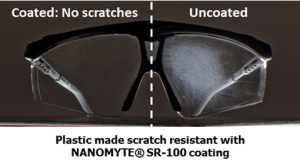 Scratch resistance is a sought-after property for coatings in a variety of applications, such as ophthalmic and sports-wear lenses, automobile and airplane windows. Plastic substrates, such as polycarbonate and acrylic, can scratch easily and lose transparency quickly during daily use and maintenance. Hard and optically transparent coatings for plastic substrates possess a significant market potential. NEI offers a patented (US Patent 9,006,370) transparent, scratch-resistant coating called
Scratch resistance is a sought-after property for coatings in a variety of applications, such as ophthalmic and sports-wear lenses, automobile and airplane windows. Plastic substrates, such as polycarbonate and acrylic, can scratch easily and lose transparency quickly during daily use and maintenance. Hard and optically transparent coatings for plastic substrates possess a significant market potential. NEI offers a patented (US Patent 9,006,370) transparent, scratch-resistant coating called 